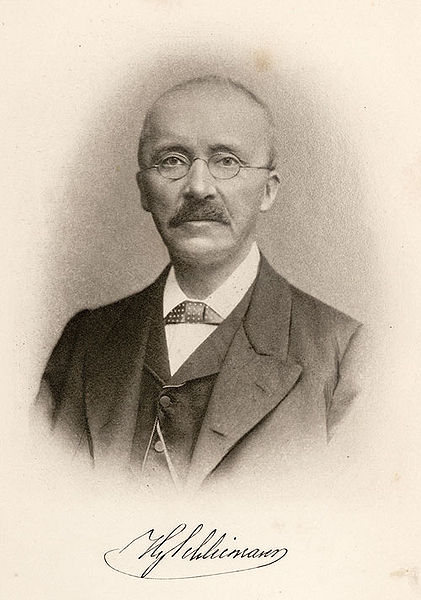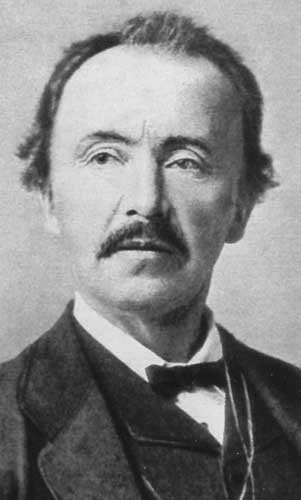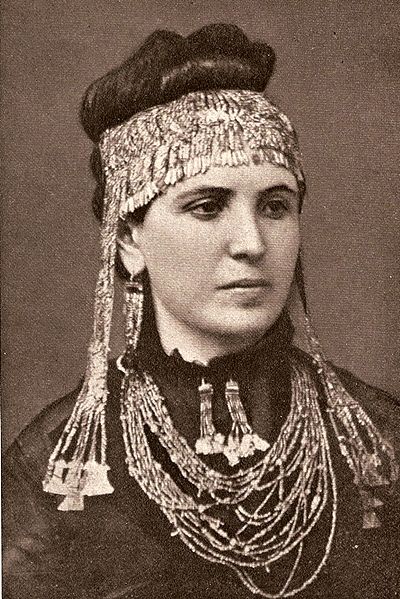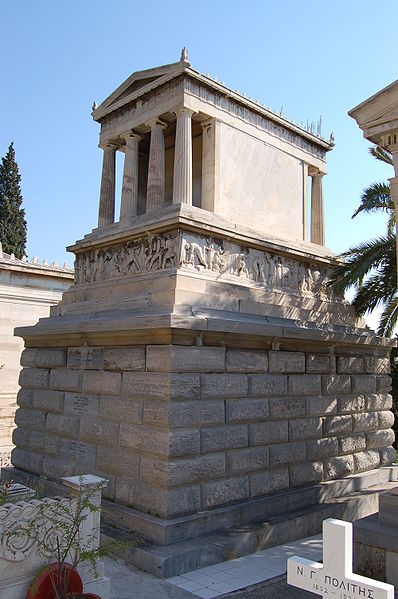<Back to Index>
- Archaeologist Heinrich Schliemann, 1822
- Author Ion Heliade Rădulescu, 1802
- Prime Minister of Spain Gaspar de Guzmán y Pimentel, 1st Count-Duke of Olivares, 1587
PAGE SPONSOR


Heinrich Schliemann (January 6, 1822, Neubukow, Mecklenburg-Schwerin – December 26, 1890, Naples) was a German businessman and archaeologist, and an advocate of the historical reality of places mentioned in the works of Homer. Schliemann was an important archaeological excavator of Troy, along with the Mycenaean sites Mycenae and Tiryns. His successes lent material weight to the idea that Homer's Iliad and Virgil's Aeneid reflect actual historical events.
Schliemann was born in Neubukow in 1822. His father, Ernst Schliemann, was a poor Protestant minister. Heinrich's mother, Luise Therese Sophie, died in 1831, when Heinrich was nine years old. After his mother's death, his father sent Heinrich to live with his uncle. When he was eleven years old, his father paid for him to enroll in the Gymnasium (grammar school) at Neustrelitz. He attended the grammar school for at least a year. Heinrich's later interest in history was initially encouraged by his father, who had schooled him in the tales of the Iliad and the Odyssey and had given him a copy of Ludwig Jerrer's Illustrated History of the World for Christmas in 1829. Schliemann later claimed that at the age of 8, he had declared he would one day excavate the city of Troy.
Schliemann's interest in the classics continued throughout his time at the Gymnasium, so it is likely that he would have been further exposed to Homer had he been able to remain a student there. However, Heinrich was transferred to the vocational school, or Realschule, after his father was accused of embezzling church funds, and had to leave that institution in 1836 when his father was no longer able to pay for it. According to his diary, Schliemann's interest in ancient Greece was conceived when he overheard a university student reciting the Odyssey of Homer in classical Greek; Heinrich was taken by the language's beauty. His family's poverty left Schliemann unable to afford a university education, so it was Schliemann's early academic experiences that influenced the course of his education as an adult. Nonetheless, he was a highly original and unconventional thinker with methods that brought him many admirers as well as enemies. He wanted to return to the educated life, to reacquire and explore the interests he had been deprived of in childhood. In his archaeological career, however, there was often a division between Schliemann and the educated professionals.
At age 14, after leaving Realschule, Heinrich became an apprentice at Herr Holtz's grocery in Fürstenberg. He labored for five years, reading voraciously every spare moment. In 1841, Schliemann moved to Hamburg and became a cabin boy on the Dorothea, a steamer bound for Venezuela. After twelve days at sea, the ship foundered in a gale. The survivors washed up on the shores of the Netherlands. Schliemann became a messenger, office attendant, and later, a bookkeeper in Amsterdam.
On March 1, 1844, 22-year old Schliemann took a position with B.H. Schröder & Co., an import/export firm. There, he displayed such talent that they sent him as a General Agent in 1846 to St. Petersburg. There, the markets were favorable. In time, Schliemann represented a number of companies. He continued to nourish a passion for the Homeric story and an ambition to become a great linguist. He learned Russian and Greek, employing a system that he used his entire life to learn languages — Schliemann spoke 13 languages, including his mother tongue and wrote his diary in the language of whatever country he happened to be in.
By the end of his life, he could converse in English, French, Dutch, Spanish, Portuguese, Swedish, Italian, Greek, Latin, Russian, Arabic, and Turkish as well as German. Schliemann's ability with languages was an important part of his career as a businessman in the importing trade. In 1850, Heinrich learned of the death of his brother, Ludwig, who had become wealthy as a speculator in the California gold fields. Schliemann went to California in early 1851 and started a bank in Sacramento. The bank bought and resold over a million dollars of gold dust in just six months. Prospectors could mine or pan for the gold, but they had no way to sell it except to middlemen such as Schliemann, who made quick fortunes on the exchanges. Schliemann also amassed a large fortune speculating on various stock markets prior to the California Gold Rush, adding to his already considerable fortune. While he was there, California became the 31st state in September 1850 and Schliemann acquired United States citizenship. According to his memoirs, before arriving in California he dined in Washington with President Millard Fillmore and his family, but there is no mention of this in the official presidential records. He also published an account of the San Francisco fire of 1851.
Schliemann was not in the United States long. Rather suddenly, on April 7, 1852, he sold his business and returned to Russia. There he attempted to live the life of a gentleman, which brought him into contact with Ekaterina Lyschin, the niece of one of his wealthy friends. Schliemann had previously learned his childhood sweetheart, Minna, had married. Heinrich and Ekaterina married on October 12, 1852. The marriage was troubled from the start. Ekaterina wanted him to be richer than he was and withheld conjugal rights until he made a move in that direction. Schliemann cornered the market in indigo (an important dye) and then went into the indigo business itself, turning a good profit. Ekaterina and Heinrich had a son, Sergey. Two other children followed.
Having a family to support motivated Schliemann to attend to business even though he still had his first fortune. He found a way to make yet another quick fortune as a military contractor in the Crimean War, 1854 - 1856. He cornered the market in saltpeter, sulfur, and lead, constituents of ammunition, which he resold to the Russian government.
By 1858, Schliemann was wealthy enough to retire. Some say he retired at 36, which would have been in 1858; others say 1863, at age 41. In his memoirs, he claimed that he wished to dedicate himself to the pursuit of Troy, whenever the exact date of the completion of his business career.
Schliemann's
first interest of a classical nature seems to have been the location of
Troy. The city's very existence was then in dispute. Perhaps his
attention was attracted by the first excavations at Santorini in 1862 by Ferdinand Fouqué.
This possibility argues for an early retirement date, as he was already
an international traveller by then. He may have been inspired by Frank Calvert, whom he met on his first visit to the Hissarlik site in 1868. Somewhere
in his many travels and adventures, Schliemann lost Ekaterina. She was
not interested in adventure and had remained in Russia. Schliemann
claimed to have utilised the divorce laws of Indiana in 1869. Using Indiana's lax divorce laws enabled Schliemann to divest himself of his Russian wife Ekaterina in absentia.
Based on the work of a British archaeologist, Frank Calvert, who had been excavating the site in Turkey for over 20 years, Schliemann decided that Hissarlik was, in fact, the site of Troy. In 1868 — a busy year for Schliemann — he visited sites in the Greek world, published Ithaka, der Peloponnesus und Troja in
which he asserted that Hissarlik was the site of Troy, and submitted a
dissertation in ancient Greek proposing the same thesis to the University of Rostock. He received a PhD in 1869 from
the university of Rostock for that submission. Regardless of his
previous interests and adventures, Schliemann's course was set. He
would take over Calvert's excavations on the eastern half of the
Hissarlik site, which was on Calvert's property. The Turkish government
owned the western half. Calvert became Schliemann's collaborator and
partner.
Schliemann
brought dedication, enthusiasm, conviction and his not inconsiderable
fortune to the work. Excavations cannot be made without funds, and are
vain without publication of the results. Schliemann was able to provide
both. Consequently, he made his name in the field of Mycenaean
archaeology. Despite later criticism, his work continues to receive
great attention and favor from some Classical archaeologists to this
day. Schliemann
knew he would need an assistant who was knowledgeable in matters
pertaining to Greek culture. As he had divorced Ekaterina in 1869, he
was able to advertise for a wife: which he did, in a newspaper in
Athens. A friend, the Archbishop of Athens, suggested a relative of
his, the seventeen-year-old Sophia Engastromenos (1852 – 1932).
Schliemann soon married her in October 1869. They later had two
children, Andromache and Agamemnon Schliemann; he reluctantly allowed
them to be baptized, but only solemnized the ceremony by placing a copy
of the Iliad on the children's heads and reciting one hundred hexameters. By
1871, Schliemann was ready to go to work at Troy. His
career began before archaeology developed as a professional field, so,
by present standards, the field technique of Schliemann's work leaves
much to be desired. Thinking that Homeric Troy must be in the lowest
level, Schliemann and his workers dug hastily through the upper levels,
reaching fortifications that he took to be his target. In 1872, he and
Calvert fell out over this method. Schliemann flew into a fury when
Calvert published an article stating that the Trojan War period was
missing from the site's archaeological record. As if to confirm
Schliemann's views, a cache of gold appeared in 1873; Schliemann named
it "Priam's Treasure."
He later wrote that he had seen the gold glinting in the dirt and
dismissed the workmen so that he and Sophie could excavate it
themselves, removing it in her shawl. Schliemann was successful in
creating public interest in antiquity. Sophie later wore "the Jewels of
Helen" for the public. Schliemann published his findings in 1874, in Trojanische Altertümer ("Trojan Antiquities"). This
publicity backfired when the Turkish government revoked Schliemann's
permission to dig and sued him for a share of the gold. Collaborating
with Calvert, Schliemann had smuggled the treasure out of Turkey,
alienating the Turkish authorities. He defended his "smuggling" in
Turkey as an attempt to protect the items from corrupt local officials. Priam's Treasure today remains a subject of international dispute. Schliemann published Troja und seine Ruinen (Troy and Its Ruins) in 1875 and excavated the Treasury of Minyas at Orchomenus. In 1876, he began digging at Mycenae. Upon discovering the Shaft Graves, with their skeletons and more regal gold (including the Mask of Agamemnon), Schliemann cabled the king of Greece. The results were published in Mykena in 1878. Although
he had received permission in 1876 to continue excavation, Schliemann
did not reopen the dig at Troy until 1878 – 1879, after another
excavation in Ithaca designed to locate an actual site mentioned in the Odyssey. This was his second excavation at Troy. Emile Burnouf and Rudolph Virchow joined him there in 1879. Schliemann made a third excavation at Troy in 1882 – 1883, an excavation of Tiryns with Wilhelm Dörpfeld in
1884, and yet again, a fourth excavation at Troy, also with
Dörpfeld (who emphasized the importance of strata), in 1888 – 1890.
On August 1, 1890, Schliemann returned reluctantly to Athens, and in November traveled to Halle for
an operation on his chronically infected ears. The doctors dubbed the
operation a success, but his inner ear became painfully inflamed.
Ignoring his doctors' advice, he left the hospital and traveled to Leipzig, Berlin, and Paris. From the latter, he planned to return to Athens in time for Christmas, but his ears became even worse. Too sick to make the boat ride from Naples to Greece, Schliemann remained in Naples, but managed to make a journey to the ruins of Pompeii. On Christmas Day he collapsed into a coma and died in a Naples hotel room on December 26, 1890. His corpse was then transported by friends to the First Cemetery in Athens. It was interred in a mausoleum shaped like a temple erected in ancient Greek style designed by Ernst Ziller in the form of a pedimental sculpture.
The frieze circling the outside of the mausoleum shows Schliemann
conducting the excavations at Mycenae and other sites. His magnificent
residence in the city centre of Athens, houses today the Numismatic Museum of Athens. Schliemann's work left much to be desired. Further excavation of the Troy site by others indicated that the level he named the Troy of the Iliad was
not that, although they retain the names given by Schliemann. His
excavations were even condemned by later archaeologists as having
destroyed the main layers of the real Troy. However, before Schliemann,
not many people even believed in a real Troy. Nonetheless Charles Maclaren identified Hissarlik as the location of Troy as early as 1822. Kenneth W. Harl in the Teaching Company's Great Ancient Civilizations of Asia Minor lecture
series claims that Schliemann's excavations were carried out in such
methods that he did to Troy what the Greeks couldn't do in their times,
destroying and leveling down the entire city walls to the ground. One
of the main problems of his work is that King Priam's Treasure was
putatively found in the Troy II level, of the primitive Early Bronze
Age, long before Priam's city of Troy VI or Troy VIIa in the prosperous
and elaborate Mycenaean Age. Moreover, the finds were unique. These
unique and elaborate gold artifacts do not appear to belong to the
Early Bronze Age. In the 1960s William Niederland, a psychoanalyst,
conducted a psychobiography of Schliemann to account for his
unconscious motives. Niederland read thousands of Schliemann's letters
and found that he resented his father and blamed him for his mother's
death, as evidenced by vituperative letters to his sisters. According
to Niederland Schliemann's preoccupation (as he saw it) with graves and
the dead reflected grief over the loss of his home and his efforts at
resurrecting the Homeric dead should represent a restoration of his
mother and nothing specifically in the early letters indicate that he
was interested in Troy or classical archaeology. Whether this sort of
evaluation is valid is debatable. He was accused of not always being
scrupulous about providing the whole truth and that his father's
experiences gave him a sympathy to means that were not always legal or
aboveboard (he has been accused of forging documents to divorce his wife and fill in false facts in his application for US citizenship). He is also accused of being a black market trader, though several documentaries from the late 80s and early 90s prefer to gloss over this accusation. In
1972, Professor William Calder of the University of Colorado, speaking
at a commemoration of Schliemann's birthday, claimed that he had
uncovered several possible untruths. Other investigators followed, such
as Professor David Traill of the University of California. Schliemann
has been accused of embellishing his stories. As mentioned above,
Schliemann claimed in his memoirs to have dined with President Millard
Fillmore in the White House in 1850. However, newspapers of the day
make no mention of such a meeting. Schliemann left California hastily
to escape from his business partner, with whom he had conflicts. In the
frontier society of the Gold Rush, cheating was punishable by lynching. He has been accused of not becoming an U.S. citizen in 1850 in
California, as he claimed; but that he was granted citizenship in New
York City instead in 1868. He has also been suspected of being granted
citizenship in New York City on the basis of his false claim that
he had been a long-time resident. The worst accusation against
Schliemann, by academic standards, is that he may have fabricated
Priam's Treasure, or at least combined several disparate finds. His servant, Yannakis, claimed that
he found some of it in a tomb some distance away, and that it contained
no gold. However, recent examination of the actual artifacts in a
museum in St. Petersburg, Russia, where they were taken as loot during
the Second World War, has shown the artifacts to be genuine.

